Stay in the know on all smart updates of your favorite topics.
Demoday #19: Mobility as a Commons worksession
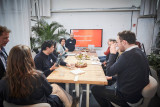
In the coming decades, urban population growth and a rising demand for mobility options will cause strain on our public spaces. The city of Amsterdam will counteract this trend by making private car ownership less attractive for its citizens, while making sure there are enough, well facilitated, alternative modes of transport. One could think of investments in (more) public transport, and the welcoming of shared mobility providers. Currently, some market players are making use of the latter and sharing cars and sharing mopeds are becoming part of the streetscape. Is this enough?
Mobility as a Commons
On the 23th of March, Diederik Basta and Jop Pék from the municipality of Amsterdam’s innovation department, hosted a working session on the concept of; Mobility as a Commons (MaaC). They introduced this concept by pointing out that currently, we’re not ‘sharing’ our modes of transport but we’re just ‘renting’ them from private companies. This raises a couple of concerns; these parties exist purely to maximize profits, they own and sell user data, their fleet of vehicles is not spread evenly throughout the city, and because it’s only available for those who can afford the service, it’s not inclusive for all.
The municipality is now exploring how to move away from these market mechanisms and facilitate car sharing solutions based in local ownership. This summer, they’ll experiment with pilots in which modes of transport are perceived as a ‘Commons’ and cooperatively owned and used by a group of local residents. Their goal is to gather insights on how to facilitate this form of locally organized mobility in the best way possible and pave the way for emerging initiatives.
Paradigm shifts
For this new alternative to succeed, drastic innovation is needed in which public authorities identify and alter their role. That’s why Diederik and Jop are also turning inwards and critically reflecting on the current premises from which they’re acting. Only then, you’ll be able to innovate in a way that you’re breaking free from your current paradigm and its effects. Because they are of such importance, I would like to quickly summarize the three relevant premises:
- People act out of self-interest; we assume mistrust. People need control and governance to reinforce the common good. Its effects: A government mistrusting its citizens and legal sealing of documents and procedures.
- The municipality owns public space. Public space should be designed and managed by experts to ensure quality, consistency and efficiency of functionalities. Its effects: Struggles with public participation and a focus on efficiency and functionality, instead of social interaction.
- The municipality is responsible for a well-functioning mobility system. Public space makes way, and more urban mobility makes people richer and happier. Its effects: Private parties push the mobility system and the government facilitates this, and traveling for work and other (social) activities is the norm.
Reactions from the participants
Next to inspiring the working session participants, Diederik and Job wanted to ignite an active conversation with the diverse group in front of them. They wanted to show the parties at the table how important it is to realise from what kind of premises and paradigm you’re currently ‘innovating’, but they were also curious what others thought of their upcoming project.
A big theme during the discussion was the fact that this ‘commons’ thinking is finding its way within different themes like the energy- and data transition. Energy cooperatives are emerging at a fast rate and this topic is receiving a lot of research and attention from energy companies at the moment. The same goes for cooperative ownership and use of data, as an alternative to protection and the commercial use of data. The different domains should be actively learning from each other, as learnings should be easily transferable. Furthermore, the group discussed the painful dilemma of the innovation department of the municipality. Their critical stance against their own policies is remarkable, but they need to find a balance where the pilot and its results will be refreshing and creative, as well as applicable in current policies as soon as possible. Finally, the group advised the presenters to; pay special attention to groups of citizens who have less time and resources available to organize themselves, write down in detail all administrative rules and obstructions that counteract these initiatives, and to not forget the power of private parties altogether; with a clear problem definition, they are able to organise and act at a fast rate.
What’s next?
In the coming months, the project’s final preparations and consideration will be implemented. Through the Horizon 2020 (GEMINI) project, The municipality of Amsterdam will cooperate with parties like Townmaking, Smart Innovation Norway, and our partner Cenex Nederland. Together they will guide and research local initiatives within Amsterdam (e.g. de Pijp, Tuindorp Oostzaan, Spaarndammerbuurt), activate a so called ‘Experimenteerregeling’ and create a plug and play system for future local initiatives. Diederik and Jop will incorporate the comments and discussions from this working session, and we’ll make sure to have them share their first learnings with the Amsterdam Smart City network later in 2023.
Do you want to know more about this topic, or would you like to get in contact with Diederik Basta or Jop Pék? You can contact me via pelle@amsterdamsmartcity.com, and I’ll connect you!
Future Mobility & Urban Space: Partners for research-by-design project wanted
We are looking for parties with experience with mobility, accessibility, mobility as a service, city logistics & delivery, autonomous vehicles, willing to think together or collaborate in a research by design project on the impact of e-commerce and remote working on future urban space and street design.
We are urban experts, with strong interest in mobility-related topics and a passion for creating more inclusive and sustainable living environments. We are in the process of submitting an application to the following grant: Ways to Wellbeing.
If interested in contributing or joining our team, please contact us via the mail below, before the end of week 8.
Contact: info@newenvironments.eu
Scale Up: houvast voor de aanpak van gedeelde opgaven

Met Scale Up onderzoekt het MRA-platform Smart Mobility samen met kennisinstellingen en de markt hoe je extreme drukte op hotspots – zoals toeristische trekpleisters, winkelgebieden en het strand – kunt voorkomen. De inzet: innovatieve oplossingen om bezoekersstromen te voorspellen en met gerichte acties te spreiden in tijd, route en vervoersmiddel. De eerste fase van het project is inmiddels afgesloten en geëvalueerd. Wat hebben de partijen opgestoken van deze manier van samenwerken en wat is de volgende stap?
In 2019 hebben de partners van het platform (Gemeente Amsterdam, de provincies Noord-Holland en Flevoland en de Vervoerregio Amsterdam) het initiatief genomen voor ‘Scale Up | Bezoekersstromen’. Het doel was het ontwikkelen én toepassen van een aanpak die helpt bij het sneller opschalen van innovaties die zorgen voor een betere bereikbaarheid van de regio. Het project heeft twee oplossingen opgeleverd die onafhankelijk van elkaar zijn ontwikkeld en getest. ‘Tijdens de testen op het strand van Zandvoort en in de Kalverstraat in Amsterdam hebben we wel gezien dat de oplossingen elkaar aanvullen en versterken,’ zegt Maarten Peters, thematrekker Smart infra bij MRA-platform Smart Mobility. ‘Tijdens de proeven op drukke plekken zagen we dat waarschuwingen in reisplanners en sociale media daadwerkelijk zorgden voor een afname van de piekdrukte. Maar liefst 60% van de mensen die achteraf een enquête heeft ingevuld, gaf aan dat hij of zij op een ander tijdstip heeft gereisd.’
Meerwaarde van Scale Up
De tests zijn afgerond, de commerciële fase van Scale Up | Bezoekersstromen breekt nu aan en er worden plannen gemaakt voor nieuwe Scale Up-onderwerpen. Daarom is dit een goed moment om samen terug te blikken, lessen te leren en vooruit te kijken naar kansen om nog meer impact te kunnen maken. Royal HaskoningDHV heeft samen met de Hogeschool van Amsterdam een evaluatie uitgevoerd. Daarin stonden drie punten centraal, vertelt Christiaan Elings van Royal HaskoningDHV: ‘Hoe kunnen we in het lopende proces van Scale Up | Bezoekersstromen een volgende stap maken voor nog meer impact, welke meerwaarde biedt de Scale Up-aanpak voor andere opgaven in de regio en hoe kunnen we ‘m daarvoor verder ontwikkelen als houvast? Hierover zijn de marktpartijen, beleidsambtenaren in de regio en het kernteam van Scale Up met elkaar in gesprek gegaan.’
Oplossingen in de hele regio inzetbaar
Het unieke en innovatieve van de Scale Up-aanpak is de manier van aanbesteden. Projectleider Anja Reimann van de gemeente Amsterdam licht dit toe: ‘We hebben het probleem uitgevraagd en niet al vooraf de oplossing bedacht. We wilden gebruikmaken van de creativiteit en kennis van de markt. Daarbij zochten we naar een werkbare totaaloplossing voor datagebruik, voorspellen en verleiden. Dat vind je niet bij één organisatie, daar is samenwerking voor nodig. Onze vraag aan de markt was daarom gericht aan consortia.’ De twee testlocaties hebben genoeg informatie opgeleverd om de oplossingen in de hele regio in te kunnen zetten. ‘Dat is het andere unieke aan dit project. De vier overheden hebben het initiatief genomen om oplossingen te zoeken voor het drukteprobleem in de hele regio. Onze eis daarbij was dat deze oplossingen overal ingezet kunnen worden. Zo hoeven gemeenten niet ieder voor zich het wiel uit te vinden. Dat hebben de consortia voor elkaar gekregen. We hebben nu een raamovereenkomst getekend met twee partijen, zodat andere overheden de oplossingen ook kunnen inkopen. De eerste opdrachten zijn al gegeven: de gemeente Amsterdam heeft de oplossingen met succes ingezet tijdens Koningsdag en Pride.’
Opschalen voor meer impact
En wat is de volgende stap? ‘Het écht op grote schaal inkopen en toepassen van de oplossingen om nog meer impact te kunnen maken. Oftewel: opschalen. Daarvoor moeten we nog een slag maken op het gebied van efficiëntie en standaardisatie, en moeten we nog nauwer samenwerken met partijen in de MRA, zoals gemeenten’, zegt Anja. Christiaan vult aan: ‘We zijn gestart met de doelstelling om te komen tot opschaling van bestaande innovatieve oplossingen, dus om goede oplossingen zo ver te brengen dat ze op verschillende plekken in de MRA kunnen worden ingezet. De eerste stappen zijn gezet. Het is nu nodig om door te pakken om de bewezen oplossingen op nog grotere schaal in te kunnen zetten in de regio.’
Samenwerken en specifieke vaardigheden van belang
Uit de evaluatie blijkt dat de aanpak werkt en inzetbaar is voor verschillende opgaven en dat de samenwerking heeft geleid tot concrete oplossingen. Deze zijn getest, maar het écht op grote schaal inkopen en toepassen moet nog starten. Opschaling vraag om specifieke kennis en vaardigheden. Veel afnemers van de Scale Up-oplossingen zijn kleinere gemeenten, legt Christiaan uit: ‘Die hebben beperkte capaciteit en geld om hiermee aan de slag te gaan. Dat is een belangrijk punt voor de volgende stap. Die moet je faciliteren.’ Dat kan, als je met een sterk team samenwerkt met die partijen, zegt Anja. ‘Als je met zo veel partijen aan de slag gaat, dan vraagt dat flink wat afstemming. De rollen en verantwoordelijkheden in het projectteam waren duidelijk, de juiste competenties waren aan boord en er was een grote drive om Scale Up tot een succes te maken. Toch werden er specifieke kennis en competenties gemist. Denk aan een financieel expert, om de stap naar de commerciële fase sneller en beter te kunnen maken, een projectsecretaris om ook de interne processen te kunnen regelen en communicatieondersteuning, zodat andere partijen eerder kunnen worden meegenomen, gericht op uiteindelijke opschaling.’
Kansen voor gedeelde opgaven
De Scale Up-aanpak is ook inzetbaar voor andere domeinen, zoals duurzaamheid, circulariteit, sociaal domein, veiligheid, sport en andere evenementen en festivals. Er is inmiddels al een tweede Scale Up in voorbereiding. Anja: ‘Scale Up biedt veel kansen. We hebben genoeg gedeelde opgaven in de regio. We kunnen deze manier van aanbesteden en samenwerken ook daarvoor gebruiken. Zo zetten we die nu in voor het aanleggen van circulaire sportvelden.’ Het is slim om opgaven aan te pakken die breed gedeeld worden, denkt Maarten. ‘Bijvoorbeeld op basis van een regionaal plan waar partijen al achter staan. Dan staat die samenwerking al. Begin 2023 besluit onze stuurgroep hoe we Scale Up verder gaan inzetten. De partners van het platform gaan hiermee dit jaar hard aan de slag. En wij gaan de boer op om onze ervaringen te delen en gemeenten actief benaderen. Deze aanpak biedt houvast bij de aanpak van grote en breed gedeelde opgaven.’
Meer weten?
De samenvatting van de evaluatie kun je hier downloaden. Wil je meer weten over Scale Up? Neem dan contact op met Maarten Peters, thematrekker Smart Infra, via m.peters@vervoerregio.nl.
Back to the Future: de Witkar, de eerste elektrische deelauto van Amsterdam
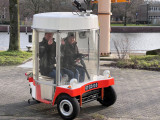
Toen ik als kleine jongen na lang zeuren eindelijk eens op de skelter van de buurjongen mocht rijden, was ik als kind zo blij. Hetzelfde overkwam me, zoveel jaren later nog eens vlak voor het einde van 2022. Door onze Community Manager Sophie was ik geattendeerd op een klein berichtje van NEMO de Studio, een soort dependance van NEMO met een eigen tentoonstelling ('energy junkies') op het Marineterrein. Praktisch buren van Amsterdam Smart City, waar ik sinds halverwege 2022 anderhalve dag per week werk op het thema mobiliteit.
NEMO de Studio ging rijden met de Witkar en je mocht mee, tenminste, als je de 'prijs' won. Daarvoor hoefde je alleen een mailtje te sturen. Nu ben ik dol op prijzen waar ik nagenoeg niets voor hoef te doen, dus dat mailtje was zo gestuurd. En tot mijn verbazing bleek ik gewonnen te hebben. Dus daar ging ik, op 29 december, naar NEMO de Studio.
Natuurlijk had ik Sophie en Pelle (mijn compagnon op het thema mobiliteit) meegevraagd en gedrieën werden we ontvangen door Jodie en Maaike van NEMO. De Witkar was aan het opladen, gewoon met een stekker in het stopcontact. Een driewieler die inderdaad grotendeels wit is, met een mooie rode bies aan de onderkant, en in de verte iets wegheeft van de Pausmobiel. Hoog en rondom ramen. Vanwege de mooie ronde koplampen doet het denken aan Brum, het oldtimer autootje met de ronde koplampen als ogen.
De Witkar reed tussen 1974 en 1986 rond in de stad. Het is feitelijk de eerste elektrische deelauto in Amsterdam. De bedenker ervan, Luud Schimmelpennink, is ook bekend van het Witte Fietsenplan. In totaal zijn er 38 Witkarren gemaakt waarvan er zo'n 25 daadwerkelijk hebben rondgereden. De autootjes stonden in speciaal gebouwde laadstations en konden door leden tegen een vergoeding gebruikt worden. Het was een non-profit initiatief; de opbrengsten werden beheerd door een stichting en werd geïnvesteerd in beheer en uitbreiding van het systeem. Hoeveel mensen er daadwerkelijk gebruik van hebben gemaakt is mij niet bekend.
En nu mocht ik het dus ook proberen. Zelf sturen zat er helaas niet in, maar meerijden is ook al een belevenis. De 'handrem' werd weggenomen, gewoon een stuk blok dat achter de wielen wordt gelegd (een echte handrem was kennelijk niet nodig). Na plaatsgenomen te hebben in de ovale coupé op het Gispen (jawel!) stoeltje naast Jodie die voor deze gelegenheid ook chauffeur was, kon het avontuur beginnen. Voor de gelegenheid hadden de dames een jaren 70 Spotify lijstje opgezet op een JBL- speakertje die achter de stoelen was gelegd (ruimte genoeg). Oude en nieuwe technologie die naadloos samengaan.
Nog even de gordel aan en hup het gaspedaal werd ingedrukt. Soepel accelereerde het karretje naar zo'n 15 km per uur. Het maximum ligt op 30 km/u maar het Marineterrein leent zich daar niet echt voor. Het ritje was niet heel comfortabel, door het gebrek aan schokdempers voel je elk hobbeltje. En door de vele kieren hebben wind en regen vrij spel. De Witkar zou in deze tijd ook ongetwijfeld worden afgekeurd voor gebruik op de openbare weg. Maar net als op de skelter destijds, heb ik ontzettend genoten. Wat een heerlijke ervaring! Comfort en gemak zijn hier niet het belangrijkste. Net zoals bij bijv. kamperen zijn andere zaken veel interessanter dan het comfort van een huisje of hotel. Plezier, authenticiteit, vrijheid, verbinding, avontuur, weg uit de hokjes, verzin het maar: de Witkar biedt het. Een mooie uitvinding van een visionaire man die zijn tijd duidelijk ver vooruit was. Dus, mag ik ajb nog een keer? Mijn buurjongetje destijds verhuisde vrij snel. Maar hopen dat deze buren lang op het Marineterrein blijven!
Mobility Justice Challenge: How do we prevent people’s exclusion in our mobility system?

Rising petrol and electricity prices; increasing digitalisation and declining public transport supply, among other things, are causing more and more people to have problems getting around. Sustainability and shared mobility do not seem to be for everyone, and measures to encourage them may even exacerbate the problem. This increases the risk of social exclusion.
The province of North Holland and DRIFT are concerned about mobility poverty and wonder what we can do about it to keep everyone in our society mobile. However, little is still known about the extent of the problem, the exact target groups and what instruments work (and what, above all, do not). We are therefore keen to engage with partners to reach a shared understanding and an aligned approach.
Since mid 2022, we have been working on this challenge with network partners in various working group sessions. Would you like to think along and be part of the solution? Contact me at pelle@amsterdamsmartcity.com.
Doctoral Thesis

I am Sener Kaya from Turkey. I am a lecturer in Ankara/Turkey. Also I am a PhD student in sociology at Sakarya University. My thesis subject is "The Transformation Revealed by Smart City Applications in Urban Identity: Amsterdam Example". Because of my thesis, I want to come to the Amsterdam and do interviews with experts who work on smart city. If you accept, I would like to work with you. I am also member of Amsterdam Smart City.
There is no study on smart cities in the field of sociology in Turkey yet. If I finish my thesis successfully, it will be the first study. I would be very happy if you support me in this matter.
My thesis's main question is '' What kind of change/transformation do smart city applications reveal in urban identity?''.
Today, many smart city applications are made by local governments. What kind of a transformation do these studies reveal in the economic, physical and socio-cultural identity of the city that it has carried from the past to the present? How do these studies carried out by local governments respond to the social problems of individuals living in the city?These are some of the sub-questions in my research. When I decided to study this topic I noticed that smart city studies generally are about physical or economic dimensions, especially in Turkey. But In studies in Turkey, this issue has almost never been addressed with its social dimensions. Therefore, I decided that this issue should be studied. Because all the elements that make up the identity of the city should be taken into account in order for the studies to be put forward by the local governments to be holistic. This is why I chose the city of Amsterdam as an example. While the work done in the city of Amsterdam was done from the top to down in the past, the work done today is done from the bottom to up and the people are at the center. I would like to come to Amsterdam and have interviews with people and institutions working on this subject. I am waiting for good news from all of you. I hope someone else accept to work with me.
#SmartThursday MRA-platform Smart Mobility over resultaten Scale Up | Bezoekersstromen

Op bepaalde plekken in de Metropoolregio Amsterdam (MRA) kan het behoorlijk druk zijn. Denk aan toeristische trekpleisters, het strand en recreatie- en winkelgebieden. Als teveel mensen op hetzelfde moment naar dezelfde plek gaan, heeft dat een negatief effect op de bereikbaarheid, leefbaarheid en veiligheid. Dat moet anders, dachten de partners van het MRA-platform Smart Mobility.
De provincies Noord-Holland en Flevoland, Gemeente Amsterdam en Vervoerregio Amsterdam werkten het afgelopen jaar samen met marktpartijen in het project ‘Scale Up | Bezoekersstromen<b>’</b>. De inzet: innovatieve oplossingen om bezoekersstromen te voorspellen en met gerichte acties te spreiden in tijd, route en vervoersmiddel. En dat is gelukt! Sterker nog: de innovaties zijn zo goed dat alle gemeenten binnen de MRA de oplossingen bij de marktpartijen kunnen inkopen en inzetten.
De oplossingen zijn getest op het strand van Zandvoort, in de Kalverstraat in Amsterdam en tijdens Koningsdag in Amsterdam. Deze testlocaties hebben genoeg informatie opgeleverd om de oplossingen in de hele regio in te kunnen zetten. De resultaten, successen en lessen van deze tests bespreken we op 19 mei tijdens een nieuwe #SmartThursday.
#SmartThursday
Op donderdag 19 mei van 16.00 tot 17.00 presenteren we de resultaten van het project ‘Scale Up | Bezoekersstromen’ tijdens een digitale bijeenkomst. Wil je meer weten over de sessie en sprekers? Of wil je je direct aanmelden? Ga dan naar deze pagina!
Where are the 'Dark Stores' in Amsterdam?
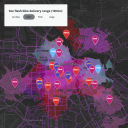
While it’s easy to find Gorillas, Getir, Flink, and Zapp flash delivery services in iTunes or Google Play app stores, It’s not so easy to locate these many grocery depots in Amsterdam.
In this interactive map we located the many physical locations of these dark stores to see the saturated landscape of flitsbezorging (flash delivery) infrastructure in Amsterdam. The goal of the map is to help consumers choose delivery services based on proximity to homes / businesses and help calm some inner city bike routes!
Curious to see the 10minute cycle zones or the locations of the many dark stores in Amsterdam? Check out this map and more information about dark stores here.
Lancering van het 'Amsterdam for All'-project

Op de demo-donderdag van 3 maart om 16 uur lanceert Gemeente Amsterdam samen met World Enabled het 'Amsterdam for All'-project. In dit project meten we met behulp van kunstmatige intelligentie de inclusieve toegankelijkheid van de stad.
We kunnen bijvoorbeeld voorspellen op welke stoepen obstakels aanwezig zijn en waar een verlaagde oversteekplaats is - handig voor de communicatie over de toegankelijkheid van winkelstraten en horeca. Zo dragen we bij aan een inclusieve stad, toegankelijk voor alle Amsterdammers.
Sprekers zijn onder andere:
- Ger Baron, CTO en Directeur Digitalisering en Innovatie bij gemeente Amsterdam.
- Dr. Victor Pineda, President van World Enabled een organisatie die zich inzet voor de inclusieve toegankelijkheid van steden.
- Maarten Sukel, AI lead bij Digitalisering en Innovatie van Gemeente Amsterdam en Phd. onderzoeker bij de Universiteit van Amsterdam. Maarten zal vertellen waarom we kunstmatige intelligentie op deze manier moeten inzetten, en geeft wat tastbare voorbeelden van projecten.
- Dr. Jon Froehlich, Associate Professor in Human-Computer Interaction bij University of Washington, waar hij onder andere werkt aan Project Sidewalk. Hij zal vertellen over het project en hoe dezelfde tool wordt gebruikt om de toegankelijkheid in Amsterdam inzichtelijk te maken.
Kom je ook?
Waarom de slimme stad een must have is?
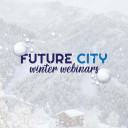
Daarover gaan we in gesprek met de opdrachtgevers en onderzoekers van het Ecorys rapport: Maatschappelijke impact van Slimme en Duurzame verstedelijking.
Het afgelopen jaar verschenen er tal van rapporten over digitalisering en technologisering. Maar wat zijn de vervolgstappen? Welke lessen kunnen we trekken voor de slimme stad? Welke ideeën kunnen ons gaan inspireren in dit nieuwe smartcityjaar?
Dit soort gesprekken voer je normaal gesproken als je elkaar tegenkomt tijdens een nieuwjaarsborrel, een congres of een andere netwerkbijeenkomst. Helaas kan dit nu even niet fysiek, maar gelukkig laat het digitale ons niet in de steek. Zo kunnen we toch met elkaar nieuwe kennis delen en verspreiden.
Daarom is de Future City Foundation op zoek gegaan naar de makers en bedenkers dit rapport. We vragen aan Jessica Dirks, Walter Hulsker (onderzoekers van Ecorys), Noor van den Brink en Caspar de Jonge (ministerie van IenW) wat er volgens hen zwaar ingezet moet worden op slimme en duurzame verstedelijking.
Datum: 24 februari, 16.00 – 17.00 uur.
Kosten: Gratis
MELD U NU AAN
Uit het rapport van Ecorys in opdracht van het ministerie van Infrastructuur en Waterstaat blijkt dat het effectief combineren en inzetten van smartcityprojecten noodzakelijke oplossingen zijn voor het ruimtegebrek in Nederland. En dat slim en binnenstedelijk bouwen niet alleen leidt tot meer leefbare steden, maar ook tot andere positieve effecten leiden, die financieel en maatschappelijk meer opleveren dan traditioneel bouwen aan de randen van steden.
Daarover gaan op donderdag 24 februari in gesprek met de onderzoekers van Ecorys:
Wilt u weten wat de meerwaarde van smartcityprojecten is? En waarom ze niet langer ‘leuk om te hebben’, maar ‘noodzakelijk’ zijn? Meld u dan nu aan!
MELD U NU AAN
Meer weten?
Wilt u zich alvast inlezen? Lees dan hier het Ecorys rapport.
User-Centered Cycling Methods Open Toolkit

Open access toolkit of people-centered methods for urban planners, designers, and advocates to make cycling inclusive and accessible to all.
How to make smart mobility hubs work for everyone? The why of citizen engagement
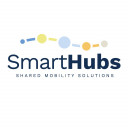
AMS Institute and SmartHubs are happy to announce the third episode of their webinar series on Mobility for the City of Tomorrow on 24 February from 14:00-15:00 (CET).
How to make smart mobility hubs work for everyone? The why of citizen engagement
There are quite some challenges for cities and other stakeholders to make mobility solutions well-tailored for everyone. It starts with finding suitable methods to engage and actively involve different user groups, such as citizens. Subsequently, they have to identify individual user needs with the traveller and co-create transport solutions for the traveller.
With citizen engagement, we try to provide the silent majority with an opportunity to raise their voice. If the SmartHubs project engages the citizen, the city-citizen relation will improve.
Marc Boijens and Laurens van Roozendaal will share some use cases and methods, actively involving the audience.
Decision support systems for locating smart mobility hubs
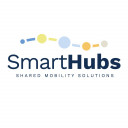
AMS Institute and SmartHubs are happy to announce the second episode of their webinar series on Mobility for the City of Tomorrow on 3 February from 14:00-15:00 (CET).
Decision support systems for locating smart mobility hubs
With the growing use of shared mobility modes comes the need to regulate and organize them into hub access points that offer several modes together. But there's a challenge. How should these hubs be located in a city so that they contribute to mobility sustainability and positively impact its urban fabric?
With that in mind, the SmartHubs project has been developing a decision support tool to help find the best potential areas for installing shared mobility hubs. It comprises a multi-criteria approach that integrates several objectives into the same overall potential score, providing cities with a geographical picture of where they should prioritize their investments.
Gonçalo Homem de Almeida Rodriguez Correia and Miquel Martí Casanovas will explain the method behind the decision support tool, using the city of Amsterdam as an example.
How to build the right ecosystem to make smart mobility hubs work?

AMS Institute and SmartHubs are happy to announce the first episode of their webinar series on Mobility for the City of Tomorrow on 20 January from 14:00-15:00 (CET).
How to build the right ecosystem to make smart mobility hubs work?
An ecosystem consists of many parties, and it's beneficial for incremental innovation if there, somehow, is a connection between them. But what if your innovation is disruptive and an entire ecosystem has to undergo a transition? How do you find the right partners for your envisioned ecosystem? How can you create a common goal that is equally beneficial for all partners?
SmartHubs are not about technology but about creating an ecosystem with a solid value proposition and the right business models.
Marc Boijens and Laurens van Roozendaal will tell you more about how they tackle the challenges they encounter in the SmartHubs project.
Collaboration in Gerontechnology
Hi dear friends,
I am interested in doing research or collaboration in projects focus on age-friendly city and smart city. An important coincidence for these fields is Gerontechnology (Gerontology + Technology). Developing mobility apps to facilitate the transportation and mobility of elders is an example of Gerontechnology. This can promote the active aging of elders in our neighborhoods and help them to do most of their outdoor activities independently. Please feel free to contact me (kazem55@ymail.com) if you think I can contribute to your company/ projects.
Thanks,
Kazem
Meet the members of Amsterdam Smart City! Ronald Smallenburg: ‘We need creativity for a new generation of infrastructure’
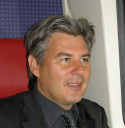
Ronald Smallenburg is co-founder of Pontiflex, a start-up which designs modular bridges out of sustainable materials.
“My business partner Joris Vermeulen and I started Pontiflex a few years ago. A key motivator was the state of the Nescio Bridge for bicycles spanning the Amsterdam-Rhine Canal between the Amsterdam suburb of IJburg and the city itself. This €15 million bridge opened in 2006, but only a few years later, its steel started to rust. It served as an inspiration to start thinking about designing more sustainable bridges on a competitive budget.
Joris asked me to join him in searching for solutions. We discovered there is a huge market for bridges and other infrastructure. A major portion of the post-WW2, so-called ‘boomer infrastructure’ in the Netherlands is at the end of its lifetime—just as it is in most Western countries. It needs to be replaced, repaired or refurbished as well as expanded, especially given the growth in cycling seen everywhere in the Western world. At the same time, society requires more sustainability. We saw excellent business opportunities.”
Alternative materials
“At Pontiflex, we believe we all need to find alternatives to classic steel and concrete, the building sector’s key materials. Their production is one of the most polluting processes in terms of CO2 emissions. That’s why we started to look for sustainable alternatives to use in new construction. They include FSC-certified wood, a revolutionary bio-composite, recycled plastics and cementless concrete made from old asphalt and industrial waste. Over the years, we were granted a total of four subsidies to finance our search for the best sustainable materials to use in new bridge construction.
Our answer to modern-day challenges is to double sustainability. Our modular bridges combine easy-to-build-and-adapt bridges with circular materials. Every element of our bridges can be replaced or reused at any time, independent of each other. This means that we can quickly build a bridge, or disassemble and move it if necessary, or adapt to new conditions, including length and width.”
Conservatism
“Developing sustainable infrastructure is challenging given the conservatism in the sector. I believe that the public sector and the industry need vision and boldness. Vision for a sustainable infrastructure, boldness in daring to design and implement new constructions and materials, either as a public client or as an architect, engineer or contractor. Calculated risks are the key words here. Do your research and test thoroughly, but dare to be different and accept your losses or approve your gains.”
New generation of infrastructure
“We participate in GO!-NH, an innovation program of the province of Noord-Holland in the Netherlands. With programs such as these, we expand our network and learn from the experiences of other entrepreneurs. I’m still new to Amsterdam Smart City, but I’m open to new connections. I’m also happy to share my entrepreneurial experience in the field of sustainability.
The Amsterdam Metropolitan Area, and the Netherlands in general, offers a lot of creativity. Here, there are many people with different backgrounds and ideas. The construction industry will benefit greatly if we tap into this diversity—not only because we need more technicians, but because we also need people who think differently. Women, migrants and refugees can provide the industry with new input and new creativity, which is crucial for a new generation of infrastructure.”
If you’d like to get in touch with Ronald, you can find himon this platform.
This interview is part of the series 'Meet the Members of Amsterdam Smart City'. In the next weeks we will introduce more members of this community to you. Would you like show up in the series? Drop us a message!
Interview and article by Mirjam Streefkerk
Green Deal ZES MRA Meetup #8

Twee jaar geleden hebben meer dan 50 publieke en private partijen uit de Metropool Amsterdam de Green Deal Zero Emissie Stadslogistiek MRA ondertekend. Daarmee gaven zij aan zich in te willen spannen op weg naar emissie-vrije stadslogistiek in 2025.
In 2025 zijn vrachtvoertuigen in de stad emissievrij. Logistieke en verkeersdata zijn slim gekoppeld. Slimme en schone (stads)logistiek is een belangrijke voorwaarde voor de economische vitaliteit en de aantrekkelijkheid van de regio. In de transitie naar slimme en schone stadslogistiek is de ondertekening van de GDZES MRA in 2019 op en 2020 – op initiatief van de Amsterdam Economic Board – door meer dan 60 partijen van grote betekenis geweest.
Maar hoe staat het er nu voor? Welke acties zijn er door overheden, bedrijven en kennisinstellingen inmiddels opgezet en wat werkt wel en wat werkt niet?
Na anderhalf jaar zoomen organiseert de Amsterdam Economic Board de Green Deal ZES Meetup#8. Op 12 oktober komen we weer live bij elkaar. Hier zullen een aantal succesvolle en onverwachte samenwerkingen worden besproken en heb jij de kans om jouw voorstel, idee of vraagstuk met een korte pitch te delen met de community. En natuurlijk worden de nieuwe ondertekenaars ook nog voorgesteld!
Het programma is als volgt:
Welkom & Introductie
Richard Hoving
Updates & Calls
Met onder andere pitches van:
- Hurby, duurzame regionale sameday avondbezorging – Mark Fontein
- Vervoerregio, Regionale Uitvoeringsagenda Stadslogistiek – Ton Geuzendam (lees ook dit interview)
- Coding the Curbs, op weg naar slimme flexibele infrastructuur – Martijn Pater
- Hogeschool van Amsterdam, Future Food Logistics Challenge – Kees-Willem Rademakers
Introductie nieuwe GDZESMRA toetreders
Met o.a. Cargoledger, Cenex Group, Open Waste, Schneider Electric, CLIC, Alliander,
Goodman, Leap24, Bidfood, Pantar, Coding the Curbs, Babboe Pro, Cipiobox, Hurby, Feenstra, HAVI en EVConsult.
Feestelijk teken- en fotomoment
GDZES MRA Netwerkborrel
Wil je erbij zijn? Dat kan! Meld je aan via de link.
Extra private SUV cars or shared mobility in your city?

In this short video (5min) Geert Kloppenburg shares his vision on shared mobility in the city.
Please respond by giving your feedback and share in your network!
https://bit.ly/Sharedmobilitynl
For feedback:
Email: geert@geertkloppenburg.nl
Redesign of public space in your own area possible?

Would this simple redesign of the public space in the suburbs of Utrecht, be an option in your area? In a special serie of short videos, Geert Kloppenburg visit suburbs of the large cities in the Randstad in Holland. Here is part 1 Utrecht. Curious what you think of the idea and feel free to share!
Watch the video here:
https://youtu.be/l_l5PRhzfVU
Amsterdam Reist Slim: doe mee aan de proef!

De gemeente Amsterdam en de Hogeschool van Amsterdam starten in november 2021 een onderzoek naar het reisgedrag van Amsterdammers. Een bereikbare en leefbare stad begint bij de behoeften van de inwoners. Hoe vaak, wanneer en met welke voertuigen verplaatsten ze zich door de stad? Dat zijn vragen waar we met de proef antwoord op willen krijgen.
Over het onderzoek
De proef wordt uitgevoerd met behulp van de slimme app Fynch. Fynch biedt niet alleen een helder overzicht van iedere gemaakte rit, ook de CO2-uitstoot, afgelegde kilometers, vermeden spitsuren en aantal minuten beweging per dag worden bijgehouden. De Hogeschool van Amsterdam onderzoekt het reisgedrag van Amsterdammers via de ritten in de app en stuurt tijdens het onderzoek twee vragenlijsten om nog meer te weten te komen over de reisbehoeften van de deelnemers.
Doe mee aan de proef
Woont u in Amsterdam en heeft u een auto? Meld u dan aan via onderstaande link! U draagt bij aan de ontwikkeling van een leefbare en bereikbare stad en ontvangt na afloop van de proef een bol.com bon van €20.
Stay up to date
Get notified about new updates, opportunities or events that match your interests.

